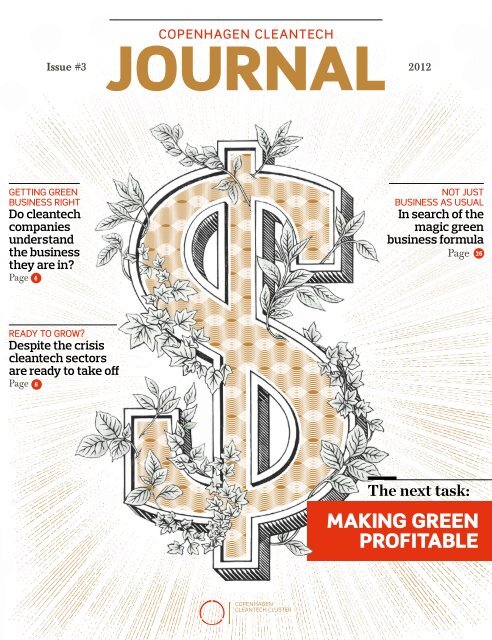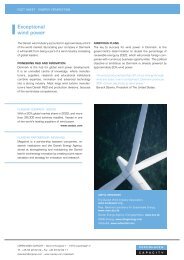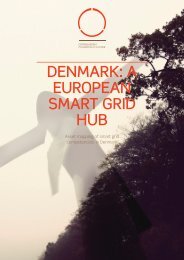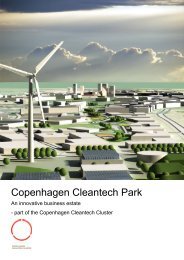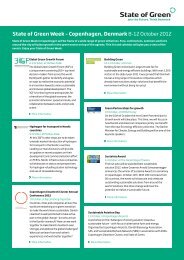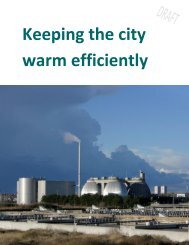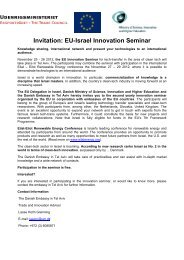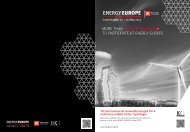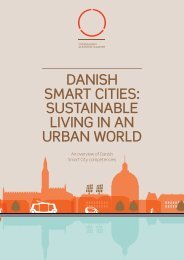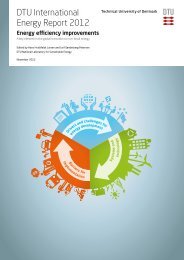MAKING GREEN PROFITABLE - Copenhagen Cleantech Cluster
MAKING GREEN PROFITABLE - Copenhagen Cleantech Cluster
MAKING GREEN PROFITABLE - Copenhagen Cleantech Cluster
You also want an ePaper? Increase the reach of your titles
YUMPU automatically turns print PDFs into web optimized ePapers that Google loves.
COPENHAGEN CLEANTECHIssue #3JOURNAL2012GETTING <strong>GREEN</strong>BUSINESS RIGHTDo cleantechcompaniesunderstandthe businessthey are in?Page4NOT JUSTBUSINESS AS USUALIn search of themagic greenbusiness formulaPage26READY TO GROW?Despite the crisiscleantech sectorsare ready to take offPage6The next task:<strong>MAKING</strong> <strong>GREEN</strong><strong>PROFITABLE</strong>
contentsGETTING <strong>GREEN</strong> BUSINESS RIGHTDo cleantech companies understand the business they are in? Page 4THE <strong>GREEN</strong> UNDERCURRENTDespite the current crisis, cleantech sectors are showing remarkablegrowth rates. The next big leap forward for cleantech is developing the bestbusiness models. Page 6TOMORROW’S BUSINESS MODELS IN THE <strong>MAKING</strong>Meet five companies that have chosen different paths to success. Page 12COLLABORATION IS THE KEY TO THE CHINESE MARKETForget about traditional marketing. It’s all about relations. Page 16BRIDGING WORLD-LEADING CLEANTECH CLUSTERSThe International <strong>Cleantech</strong> Network – recent projects. Page 19MEGACITIES ARE CHANGING THE CLEANTECH SECTORKey findings from the Global <strong>Cleantech</strong> Report 2012. Page 20GLOBAL CLEANTECH GROWTH AT A GLANCESee what’s growing – and where – on the world map. Page 22WANTED: SUPPORT FROM DOMESTIC MARKET!Danish Biokube has global success despite difficulties at home. Page 24Rasmus Juul12 3IN SEARCH FOR THE MAGIC BUSINESS FORMULAComing up with a precisely tuned business model is the key to success inthe cleantech industry. But what will work? Leasing, sharing, licensingor …? <strong>Cleantech</strong> writer and advisor Michael Kanellos on lessons learnedand future trends. Page 26the copenhagen CLEANTECH REGIONFive examples of green business thinking Page 30A NATIONAL CLEANTECH EXPLORATORIUMDenmark has become the world’s hotbed for the development of cleantechcompanies, according to a new international analysis. What’s the secret?Page 34OPINION: THE <strong>GREEN</strong> EDGEEU Commissioner for Climate Action Connie Hedegaard on cleantech’sindustrial potential Page 38Issue #3 · 2012 | 3
FocusThe greenundercurrentThe technologies are in place, and prices are falling quickly.The next big leap forward for cleantech is developing the bestbusiness models. Underneath the current positive politicalclimate and lack of capital, developments continue in highgear. However, the fervent political embrace runs a risk ofgiving the entire industry a bad reputation as unprofitable.By Sune Aagaardver the next decade, the revolutionarychanges in the global cleantechOmarkets will not stem from technologicaladvances but rather fromnew business models. The technologicaladvances will continue– and at an accelerated pace – butthe business side is where we arelagging and where there are hugegains to be made.“All along the new value chains that areemerging, there is untapped business potential.At the moment, we see new players working hardto find the most lucrative models, but the core –attractive products at competitive prices – is alreadya reality in most cleantech markets,” saysRon Pernick, founder of the research and con-6 | <strong>Copenhagen</strong> <strong>Cleantech</strong> Journal
The nations that reach the green worldfirst are the ones that will create thebest possible conditions for developinggreen business models.ron pernick, clean edgeity depends on a rational political climate. Optimismin relation to the political system – at leastin the USA – can only be based on the fact thatthe past two years have represented rock bottom,from which things can only get better,” saysRob Day.It is also his opinion that cleantech is no longerdependent on political support and subsidiesto be financially sustainable. However, just assubsidies flow to traditional types of energy,cleantech will remain deeply ensnared in politicsin the foreseeable future.“Wind energy is probably the area where thisis most visible because of the varying tax incentives.We have a long and very unflattering historyin this area in the USA, and the effects arehighly visible. We get a “boom-and-bust” economy,and it is this kind of situation that impacts acompany like Vestas in Denmark,” says Rob Day.The green bubbleInjection of capital, or lack thereof, has beensomething of a problem child for the cleantechmarkets in recent years. The current debt crisisIndustrialization willyield significant costreductionsLevelized cost of electricity, solarpower* – 2011-20200,300,280,260,240,220,200,180,160,140,120,100,080,062011-15 2016-20Note*: c-Si multicrystalline solar PV system Source: McKinsey&Company: Solar Power, May 20128 | <strong>Copenhagen</strong> <strong>Cleantech</strong> Journal
has caused the credit markets for all investmentsinvolving even the smallest risk to dry up. Beforethe debt crisis broke out, there was plenty ofventure capital, but the atmosphere has changed– because of the crisis, because of general scepticismregarding the commercial potential ofgreen projects and finally because of dramaticchanges on the supply side. Shale gas, which isfound in very large concentrations and can nowbe extracted inexpensively in countries like theUSA and China, represents a game changer thatis pushing cleantech down the agenda.The Danish investor Per Wimmer has helpedfinance cleantech projects all over the worldfor years. He is currently putting the finishingtouches on a book about the green bubble – thatis, the many investment opportunities that arosebecause of the positive political climate, andwhich resulted in inflated prices on everythinggreen. Per Wimmer points out that even the waygreen projects are financed, typically with debtfinancing of 70-80 per cent, represents a barrierto development of the markets.“This is the situation at the moment. Manyprojects can’t be realised, while others are seriouslydelayed due to difficulties obtaining capital,even for healthy projects,” he says.At the same time, central governments aremuch more reluctant to contribute to financingthrough favourable conditions in the form offeed-in tariffs and subsidies. Within solar energy,solar cell prices are plunging. There used to be atime lag between when prices fell and when centralgovernments lowered their feed-in tariffs.“That’s no longer the case. Today, everythingmoves very fast, simply because of increasingpressure on the economies,” says Per Wimmer.However, there are also signs that can justify adegree of optimism. They are linked to the conceptof grid parity, which is the point at which renewableenergy costs the same as conventionalThe sharing economyNew business models are popping up in unexpectedplaces at the moment. One of the strongest trendsinvolves sharing. Lisa Gansky is a digital entrepreneurand author of the book Mesh, which is aboutjust that – sharing. In her book, she presents a largenumber of examples with relevance to cleantechand the entire issue of sustainability. This includeseverything from car sharing, bike sharing, officesharing and house sharing to much looser ideasabout what it means to be at work.Behind this trend lies a pronounced mental shiftwith significant consequences.“The big car manufacturers have already investedin car sharing projects in recognition of the factthat owning something is becoming less essentialcompared to the importance of having access tosomething. In simple terms, this trend means thatin future we will utilise our resources much better.And this is something the largest companies havecome to realise – before ordinary people,” says LisaGansky.In Lisa Gansky’s view, things that go unused are nodifferent than rubbish, and the changes in thinking inline with technological advances mean that we canactivate things to a much greater degree than hasotherwise been possible.“Bike sharing already exists in more than 300cities all over the world and is the fastest growingmode of transport in the world. This kind of generosityculture will have a very positive impact on theglobal environment,” says Lisa Gansky.Issue #3 · 2012 | 9
Global Clean-EnergyMarket Size 2000-2011Global Market Size, USD Billions100806040200201120102009200820072006200520042003200220012000Wind PowerSolar PVBiofuelsenergy without subsidies. See also figure page 8.“Particularly in the area of solar energy, wecan see that we will reach grid parity very soon.Prices are falling dramatically, due to technologicaladvances and scaling, but also because thegreen bubble has led to greater excess capacity inproduction. The scepticism that many investorscontinue to feel towards solar energy is thereforealso about the upper limit for the distribution ofSource: Clean Edge, Inc., 2012the technology. There are simply limits to thesize of the areas we can cover with solar panels,”says Per Wimmer.However, he emphasises that new projects arecropping up all the time, which do manage to attractcapital. And feed-in tariffs still play a role,even though they are lower now that they were afew years ago.“If you install this year, you know the level ofyour feed-in tariff for the next 20 years, guaranteedby the state. Naturally, this makes investmentmore attractive,” he says.Much, much cleanerThe undercurrent that Ron Pernick and otherindustry observers are talking about is no morehidden than it can be read in a number of soberfigures. For example, global turnover within solarenergy, wind energy and biomass increasedby 31 per cent in the period 2000-2011, from USD188 billion to USD 246 billion. See figure to theleft.Most of this growth stems from a boom inthe installation of new solar energy plants andmore wind turbines. Solar energy, in particular,is attracting a great deal of attention because offalling prices. Solar cells are made from silicone,which of course invites comparison to the fallingprices of computer chips. Furthermore, this declinein prices is self-fuelling because the lowerthe prices the greater the economies of scale.“In the period 2007-2011, the total expensesfor purchasing, installation and operation of solarenergy plants were cut in half. Solyndra’s failureshows us, among other things, that in orderto succeed in this market today, you have to becheap. And this can only be seen as a healthy developmentfrom a somewhat larger perspective,”says Ron Pernick.At the same time, venture capital investmentsgrew by 30 per cent in the US market, approach-10 | <strong>Copenhagen</strong> <strong>Cleantech</strong> Journal
global snapshotsTomorrow’sBusinessModelsin the makingFUNCTIONAL SALESAll over the world, cleantechcompanies are finding newways to turn green solutionsinto good business. Someemploy classic businessmodels in innovative ways,others find entirely newways to handle the specialchallenges of these markets.Meet five companies thathave chosen different pathsto success.By Christian Mohr Boisen12 | <strong>Copenhagen</strong> <strong>Cleantech</strong> Journal1Volvo Aero and Better Place– power by the hourVolvo Aero manufactures aero-engines. But insteadof having to buy the actual engine, the customeris offered the option of purchasing the engine’spower in the form of number of kilometresflown – according to a principle known as “powerby the hour”. Volvo Aero carries out maintenanceon the engine as well.This business model is called Functional Salesand can have major advantages, both financiallyand in terms of the environment. The modelgives Volvo good reason to optimise its motors,guaranteeing a durable product with low costsand lower fuel consumption and reducing theairplane’s environmental footprint.On the ground, Better Place is using a similarbusiness model. The company supplies infrastructurefor electric vehicles (EVs) in the formof public charging stations and battery swap stations.In Denmark, Better Place offers EV ownersvarious subscriptions based on the numberof kilometres driven. For a start-up fee and asubscription fee, the customer gets a privatecharging station installed in the home as well asunlimited access to the company’s network ofpublic charging stations. Electricity is includedin the price, as is 24-hour access to customer serviceand support.
2THE POLITICAL MARKETGreen Instruments– ahead of statutoryrequirementsGreen Instruments makes equipmentfor measuring, analysing and registeringemissions of harmful particles,gases etc. in the shipping industry.Green Instruments is a world leaderwithin measuring devices for the shippingindustry, which is subject to newglobal requirements to reduce SO2emissions as well as even more restrictiverequirements in selected regions.Consequently, the entire sectorwill need to document their compliancewith the new requirements, andGreen Instruments is in the processof developing new technology thatmatches the new regulations.The company’s business model is tooperate ahead of statutory requirementsso that companies can documenttheir compliance with the newrules from day one. Furthermore,Green Instruments continuously developsthe technology as changes aremade in the legislation. The challengeis to time the product developmentand marketing just right in order tobe among the first to present the newsolutions.Green Instrument is now attemptingto get this timing right as they preparetheir technology for the anticipatedfuture changes in regulation – includingnew requirements to reduce emissionsof the nitrogen oxides, NO andNO2.ESCO3Danfoss Solutions– guaranteed energy savingsEnergy Saving COmpanies (ESCO) constitutea green business model which consists in all itssimplicity of optimising buildings, manufacturingplants and the like and receiving paymentvia achieved savings on water, heating, electricityetc. Thus the customer does not have to payanything up front.One such ESCO is Danfoss Solutions. They offerto review the customer’s buildings and/or industrialprocesses, identify potential energy savingsand implement energy-efficient initiatives. AndDanfoss Solutions guarantees the promised savings.Danfoss Solutionsfocuses on how andwhen the client canachieve the mostenergy savings fortheir money. Theprocess involvesboth streamliningthe actual industrialprocesses andoptimising cooling,heating and airconditioning in thecompany’s buildings.With the ESCO model, both parties profit fromthe energy renovation. The ESCO company proposeschanges and then usually carries out operationsand maintenance for a specified period oftime. This gives the ESCO a powerful incentiveto make the solutions as energy efficient as possible.Furthermore, the customer receives compensationif the savings turn out to be less thanagreed.Issue #3 · 2012 | 13
global snapshotsSTRATEGIC PARTNERSHIPSSemprius and Siemens –a match made in heaven4Semprius from North Carolina inthe USA develops HCPV modules, asolar energy technology with globalpotential. As a relatively small company,Semprius lacked the investmentcapital needed to build up both therequired production capacity and thevital sales channels. One element wasmissing from the business model.For Semprius, the solution was a strategicpartnership with Siemens. Byjoining forces with a global brand,Semprius could quickly boost its productioncapacity as well as the size ofits staff – not to mention gaining accessto global sales channels.Semprius has received a total of USD20 million from Siemens – as well asfrom other companies which were inspiredto invest by the German technologygiant’s participation. Thanksto the partnership Semprius couldbegin building its first factory in July2011.In exchange, Siemens now owns onesixthof the shares in Semprius andhas obtained first-hand access to anextremely promising technology.The collaboration has led to the developmentand manufacturing of theworld’s most efficient solar panels todate.For smaller companies, this modelcan be a way to make giant strides inthe difficult and crucial commercialisationphase. This is especially relevantfor the cleantech area, wheremany innovators have a technologicalstarting point but often lack both thecapital and the business resources tomanufacture and sell their productsglobally.14 | <strong>Copenhagen</strong> <strong>Cleantech</strong> Journal
During the next 15 years, 400 million Chinese will move from rural areasto cities. This creates a huge market for prefabricated, sustainablebuilding units. The Danish-Chinese export cluster is well underway withrethinking business models, product development and marketing.By Jesper AndersenCollaborationis the key to theChinese marketThe Chinese middle classis experiencing explosivegrowth, and as prosperityincreases, people aremoving in droves from therural areas to China’s cities.In 2012, around 9 millionhomes will be built in China, butwithin just three years, that figureis expected to be nearly 35 million.By 2020, half of all new homes in theworld will be built in China.In just a few years, private homesin China will be responsible for morethan half of the country’s energy consumption,which is why China has aclear interest in increasing the use ofsustainable, prefabricated modularbuilding units. This is an area whereDenmark holds a strong hand. Thetrick is to play your cards right, becausethe Chinese market differs radicallyfrom western markets.“In China, we can forget all abouttraditional marketing. The Chinesemarket is all about relations – to theright partners, to the authorities, tothe state and to the universities. Tothe Chinese, good, trusting relationsare worth more than a contract. Butsince building relations takes a longtime, only the largest Danish companieshave had the resources to establisha presence in China on their own.But 80 per cent of the Danish businesscommunity are small and medium-16 | <strong>Copenhagen</strong> <strong>Cleantech</strong> Journal
About FISH ChinaExport cluster for Danish and Chinese companies,universities and authorities interested in the sale anddevelopment of sustainable building units in the Chinesemarket. The cluster is developed and run by theDanish Chinese Business Forum, the Danish ExportAssociation, the Danish Trade Council and the DanishTechnological Institute.For further informationvisit china.fishclusters.dk orcontact Anders Thomsen,Centre Manager, BuildingTechnology Management,Danish Technological Instituteon: +45 7020 2236 or byemail: ant@teknologisk.dk.for new ways to lower prices withoutcompromising on building quality. Agreen roof with many cleantech featuresdoes not necessarily have tobe 100 per cent nationally manufactured.Some of the components couldbe replaced with ones made in China.Or some of the most time-consumingprocesses could be carried out in China.An industrial worker in China onlycosts 1/25 of a Danish worker’s wages.In an effort to support the collaborativeprocesses that will lead to morecompetitive prices, FISH China is carryingout demo projects in both Chinaand Denmark. For example, in 2012two identical houses will be built inthe Danish provincial town of Horsensand the Chinese town of Wuxi.With the same point of departure,Danish and Chinese partners can enterinto a dialogue on how the houses’building costs can be reduced withoutcompromising on quality and sustainability.This is the key to the hugeChinese market, according to AndersThomsen.Concepts are difficult to copyStandardised modular building unitsalso address another market issue inChina: protection of property rights.The Chinese legal system does notprovide the same protection as the18 | <strong>Copenhagen</strong> <strong>Cleantech</strong> JournalEuropean one, when it comes to infringementof property rights.In this area, Anders Thomsenbelieves there are two possible approaches:A company can spend loadsof time protecting their propertyrights, often with only limited success.Alternatively, the company can spendtime being a first mover and make itsproducts difficult to copy, in close collaborationwith local Chinese companies.“If you come with a window, it’s anobvious target for copying, because itcan be used all over the place. But ifthe window is integrated into a standardisedmodule that only has value incombination with other modules – accordingto the LEGO principle – it ismuch more difficult to copy. But youhave to take care that you’re not seeingghosts. I believe that our Chinesepartners have a genuine and longterminterest in collaborating withDanish manufacturers,” says AndersThomsen.The key is to listenCommercial success in China is aboutmore than price and protection ofproperty rights. It also requires a willingnessto play according to China’srules and to be constantly visible inthe market. Chinese society is characterisedby a great enthusiasm fordevelopment and change, and so theChinese are especially interested inproducts that they can help developfurther.“It’s useless to come to the Chinesewith a myopic focus on your own productand everything you think it cando for them. That kind of monologuecan easily result in a “No thanks”.The Chinese expect to be listened toand they expect us to be willing to getclose and make an extra effort to understandtheir needs. With object-orientedproduction platforms, we canoffer to let their own design agenciescome up with the combinations anddimensioning that produce the buildingsthey are looking for without pricesgetting out of hand. This approachis much better suited to the Chinesementality than turnkey solutionswhere even minor changes can upsetthe budget,” says Anders Thomsen.Jesper Andersen is a cleantech writer and founderof the danish communication agency Greenster.
UpcomingICN meetings:Autumn 2012 – ICN host: Singapore (22-25 October)Spring 2013 – ICN host: Renewable Energy HamburgAutumn 2013 – ICN host: Colorado Clean Energy <strong>Cluster</strong>More information is available atwww.internationalcleantechnetwork.comThe International <strong>Cleantech</strong>Network (ICN)… was founded in 2009 by <strong>Copenhagen</strong><strong>Cleantech</strong> <strong>Cluster</strong> andColorado Clean Energy <strong>Cluster</strong>.As of March 2012, the network’spartners are:• Renewable Energy Hamburg(Germany)• Lombardy Energy <strong>Cluster</strong> (Italy)• Tenerrdis (France)• ACLIMA (Spain)• Eco World Styria (Austria)• OREEC (Norway)• Singapore Sustainability Alliance(Singapore)• Research Triangle Region <strong>Cleantech</strong><strong>Cluster</strong> (North Carolina,US)• Colorado Clean Energy <strong>Cluster</strong>(Colorado, US) and• <strong>Copenhagen</strong> <strong>Cleantech</strong> <strong>Cluster</strong>(Denmark).Bridging the world’s leadingcleantech clustersThe International <strong>Cleantech</strong> Network is the international outreach platformfor the world’s leading cleantech clusters. Here are a few examplesof projects in 2012, where <strong>Copenhagen</strong> <strong>Cleantech</strong> <strong>Cluster</strong> interacts withits ICN partners.Danish-French collaboration on hydrogen and fuel cells<strong>Copenhagen</strong> <strong>Cleantech</strong> <strong>Cluster</strong> and ICN’s French member, Tenerrdis,are working to establish bilateral partnerships between French andDanish companies and research institutions in the hydrogen and fuelcell sector. In June 2012 the potential for fuel cells and future projectsin Denmark were presented at a Tenerrdis event with local companies.The next step will be to match French and Danish companiesfor future projects and commercialisation.Joint ICN project on waste-to-energyThe ICN members from Oslo Renewable Energy and Environment<strong>Cluster</strong>, Lombardy Energy <strong>Cluster</strong>, Eco World Styria, Renewable EnergyHamburg, ACLIMA Bilbao and <strong>Copenhagen</strong> <strong>Cleantech</strong> <strong>Cluster</strong> haveapplied for funding from the ‘Regions of knowledge programme’ underthe European Commission to carry out a waste-to-energy researchproject. Entitled COOLSWEEP, the project aims to coordinateregional knowledge in order to initiate a sustainable and optimisedEU waste–to-energy programme.Innovation express in Austria and SingaporeIn partnership with the National Innovation Network for EnvironmentalTechnology, the <strong>Copenhagen</strong> <strong>Cleantech</strong> <strong>Cluster</strong> has beenawarded funding to establish closer ties to two other ICN regions:Eco World Styria, in Austria, and the Singapore Sustainability Alliance.A delegation from <strong>Copenhagen</strong> will visit both regions, focusing onhelping companies connect with potential partners and identifyingpotential R&D projects within the waste sector (Austria) and watersector (Singapore).<strong>Copenhagen</strong> water delegation to SingaporeAs partners through the International <strong>Cleantech</strong> Network, <strong>Copenhagen</strong><strong>Cleantech</strong> <strong>Cluster</strong> and Singapore Sustainability Alliance joinedforces at the 2012 International Water Week in Singapore, whichwas held on 1-5 July. <strong>Copenhagen</strong> <strong>Cleantech</strong> <strong>Cluster</strong>’s delegation ofwater companies spent the week meeting with potential Singaporepartners.Issue #3 · 2012 | 19
perspectiveMegacities are changingthe cleantech sectorfrom withinAn integrated approach to ECO-cities will lead to citiesbecoming the main driver of cleantech markets on aglobal scale. For European companies, partnerships andmore integrated business models could be the bestchance to regain their position of strength. The “Global<strong>Cleantech</strong> Report 2012” explores why and how.By Kanval SheikhEurope, once considered a frontrunnerin the cleantech sector, is rapidlylosing its leading position. If Europeancompanies want to maintain asustainable competitive advantageand increase their share of the globalcleantech market, they need to thinkbusiness in a whole new way. This isone of the key conclusions of the comprehensive“Global <strong>Cleantech</strong> Report2012”, recently published by <strong>Copenhagen</strong><strong>Cleantech</strong> <strong>Cluster</strong> and the DanishIndustry Foundation.In the past 3-4 years, the role of citieshas changed. While market growthwas once defined from a nationalperspective, today cities are increasinglyperceived as individual growthdrivers. The new report looks at howcompanies approach the new businessopportunities arising from the changingrole of cities. It suggests that partnershipsand holistic solutions ratherthan stand-alone business approacheswill have a greater chance of capturingcleantech markets in future.Smart ECO-city ambitions– the new normThe world’s 30-largest cities are projectedto drive 20 per cent of theglobal GDP growth from 2010 to 2020,and the top 600 cities are expected todrive 60 per cent of the growth. Consequentlycities are an ideal platformfor collaborative decision-making andfor enabling a holistic one-system approach.And this will enable cities tocreate an investment framework thatfocuses on long-term financial, societaland environmental sustainability.This development is clearly showcasedin the number of profiled ECOcitycollaborations and projects,which has grown significantly in recentyears, primarily driven by Asia’sfocus on using ECO-cities as a meansof driving the development of efficientcities.To counteract the negative impactof the expanding cities and to providehigh quality of life to its residents,cities will need to invest in sustainableinfrastructure encompassing allcleantech sectors. Thus there is a globaltrend to rethink the urban developmentmodel branded as the ECO-city,delivering system benefits to the cityrather than following a piecemeal approach.An integrated approach will leadcities to become the main driver ofcleantech markets globally – and iskey to understanding the cities’ needsfor cooperation and partnerships withcleantech players. If they are to keeppace with urbanisation while ensuringthat residents can maintain theirexisting living standards, city administrationsneed to think in terms ofthe entire value chain – and companiesbidding for projects need to dothe same.Green comfortThe report groups megacities intothree categories:1. Affordable greening, e.g.Lagos: These are cities driven byextreme urbanisation and low GDPwith a need for extensive growth innew housing. Making new housingand infrastructure “green” cancreate the lowest total CAPEX forwater, electricity and waste.2. Comfort evolution, e.g. MexicoCity: This trend is evident in mostlarge and fast-growing cities indeveloping countries. In spiteof increasing urbanisation, thefocus is on increasing liveability inthe cities through buildings withimproved comfort, more efficienttransportation and, most importantly,clean water and clean air.3. Green comfort – the brandedcity, e.g. London: Large cities,primarily in developed countries,are to some extent competing toattract leading companies andto be the most attractive place tolive. ECO-city projects are not a“need”-driven ambition but an effortto create a better place to liveand work.Partnerships lead to business inthe cleantech sectorThe “Global <strong>Cleantech</strong> Report 2012”concludes that complex value creationmodels with local content need to beinvestigated and developed in order tomeet the demand for competitive integratedsolutions. Incorporating localcontent into solutions for cities isa growing trend, highlighting the dif-20 | <strong>Copenhagen</strong> <strong>Cleantech</strong> Journal
ficulties inherent in today’s cleantechbusiness opportunities. The approachrequires cooperation with local stakeholdersand strong cleantech businesscases across regions to meet the needto focus on obtaining value from multiplesources.Often it is not enough to encounterdirect savings or compare direct ratesof returns. For cities in developed anddeveloping countries it is crucial toestablish value propositions and businesscases that focus on the systemvalue rather than the project itself.However, the value propositionsmay differ between an ‘affordablegreening’ case, where green systemthinking includes savings on electricitygeneration, water and wasteinfrastructure, and a ‘branded city’case, where the value is the ability tomaintain and attract key people andcompanies. Thus a strong value propositioncombined with insight into thefuture needs of cities can foster longtermbusiness relations and open upmarkets that are not yet known to bestrong cleantech markets.Finally, the report establishes thatsmall and medium-sized enterprisesneed to strengthen their collaborationwith larger corporations, which possessthe resources and knowledge todeal with the changing cities and theircomplexity. The cases of Siemens andKeppel Corporation (see page 14 and15) are good examples of this trend.Kanval Sheikh is business developer at <strong>Copenhagen</strong><strong>Cleantech</strong> <strong>Cluster</strong>The battle of thecleantech sectorKey considerations Key beliefs RecommendationsBusinessstrategyHow, and in what order, should youaddress the different subsegmentsinthe market (cities/geographies)?Community presence andrelationships are critical topave the way for commercialsuccess in megacitiesThe right place: large citiesRelations must be build with stakeholderon city level globallyValuepropositionGo-to-marketmodelTo what extent is your stand-aloneoffering unique and innovative in themarket in terms of other solutionsfrom competitors and substitutes?How can your company best succeedin the market with the newchannel needs and market logic?Megacities are demandingintegrated solutions in whichpreviously independentcomponents and services arebundledThe right partners: leading solutionprovidersParticipate in PPP and Partner withleading solution/turnkey providersOrganisationalcapabilities• As a stand-alone company only offeringown products and services• Through partnerships with otherplayers offering more integratedsolutionsWhat are the organisational requirementsneeded to be able to addressthis new channel/market?Local economies and societalagendas are highest priorityfor megacity stakeholdersThe right offering: local needs andlocal value creationDevelop offering and new businessmodels embracing complex valuecreation and multiple bottom linesat local levelTo what extent do your currentgovernance and competences matchthe needs?Source: MEC Intelligence analysis; Quartz+Co analysis.See also the “Global <strong>Cleantech</strong> Report 2012”, Executive Summary.Issue #3 · 2012 | 21
The global markets for cleantech<strong>Cleantech</strong> sectors expected to grow by more than10 per cent annually and the total value of cleantechmarkets on each continent, 2010-2015.North America94 bn USD181 bn USD2010 2015Annual growth14%south America11 bn USD26 bn USDAnnual growth19%2010 2015<strong>Cleantech</strong> Growth at a Glance<strong>Cleantech</strong> markets are predicted to grow on every continent on theglobe – despite the current crisis in the world economy. Europe will stillbe the dominant cleantech continent in three years; however impressivegrowth rates in North America and Asia will gradually change the ”centreof gravity” for the future of cleantech innovation.
europe2010 2015Annual growth4%Annual growth15%asia2010 2015africa8 bn USD16 bn USD198 bn USD243 bn USD142 bn USD287 bn USD2010 2015Annual growth14%australia13 bn USD19 bn USDAnnual growth8%2010 2015cleantech sectorsBioenergySolid wasteOffshore windSmart gridGeothermalSolarClean waterOnshore windClean road/EVBuildingmaterialsIssue #3 · 2012 | 23
challengeWanted:Support from domestic market!Over just a few years, BioKube, a small Danish cleantechcompany, has generated millions in revenue in foreignmarkets. Their business model is a combination of outsourcing,network sales and export subsidies. However,their success has been achieveddespite difficulties with havingonly very few strong referencesfrom the domestic market.By Ulf Joel JensenPhoto: Per WesselCEO Morten Brix and founder PeterTaarnhøj in front of one of theirbiological waste water treatmentsystems sold worldwide. Somepotential international customersare still skeptical about the lackof references from the domesticmarket.On the outside, BioKubedoes not look likemuch with its somewhatisolated locationin a business park nearthe small Danish provincial town ofTappernøje. While the buildings containa demonstration area, offices anda development department, the cleantechcompany makes do with a staff ofonly 15. Not what you would expectfrom a company that exports its biologicalwaste water treatment systemsto 43 countries all over the world.But this is a conscious strategy, explainsBioKube CEO Morten Brix:“Our business model is based on24 | <strong>Copenhagen</strong> <strong>Cleantech</strong> Journal
networks: We have outsourced theentire production process and a largeshare of sales, simply because thecleantech market is so new and sensitive.We work with waste water treatment,which is a highly regulated area.It is therefore very risky to becometoo tied up when we’re still such a relativelysmall player in the market,” hesays. And company owner and founder,Peter Taarnhøj, adds:“The cleantech market only existsthanks to legislative initiatives andregulatory requirements. BioKubehas developed in the wake of the EUWater Framework Directive of 2000,which dictated that all surface waterin the European Union must be cleaner.Ultimately, this meant that 25 millionhouseholds in the EU would needto treat their own waste water – andthis has created a new market wherewe have gained a foothold.”A sluggish domestic marketAfter two years’ development workand patent applications, the companysold the first biological waste watertreatment systems to Danish farmersin December 2004. Two years laterthey landed the first export orders –with a good deal of help from the Danishaquatic plans – with some of thestrictest environmental requirementsin the world. So because BioKube’swater treatment systems meet the requirementsof the domestic market,they also meet the requirements inthe rest of the world. Today, approx.60 per cent of the company’s revenuecomes from the export market.This means that less than half ofBioKube’s revenue comes from thedomestic market. And yet, while thecompany provides support and servicefor their Danish systems, thesefunctions in other countries havebeen outsourced to their network.Consequently, the figures show thatmany more and much larger systemsare sold internationally than withinDenmark’s borders. And this leavesthe top management in Tappernøjeboth disappointed and puzzled:“It’s very difficult for us to breakinto the market for medium-sized systemsin Denmark. We sell a lot of smallsystems to private individuals, but it isdifficult to sell new technological solutionsto the public sector, even thoughwe meet all the regulatory requirementsand have competitive prices,”says Morten Brix.Customers don’t understandFei Chen is Innovation Platform Directorat Grundfos as well as chairpersonof the Danish innovation networkfor environmental technology, Inno-MT. She emphasises the importanceof being able to refer to success in thedomestic market, and believes that ingeneral the public sector could play amore active role, for instance by investingin showcases and demonstrationplants:“Many small and medium-sizedenterprises in the cleantech sectordon’t have the capacity to finance suchthings. So public investments could bea huge help when it comes to demonstratingto the rest of the world howfar we have actually come with thetechnology,” says Fei Chen.And yet, while BioKube has gained afoothold in the export market and hasnow sold enough systems all over theworld to secure strong documentationthat the technology works, they stillmeet scepticism from potential internationalcustomers when they have toexplain that in the domestic marketthey only sell their small systems toprivate individuals.Sometimes this can even be a barrier,such as when the company triedto sell their product to the US military,which lost interest once they learnedthat the Danish military does not useBioKube’s solutions.Learn from Singapore“It is, of course, bad for our businessthat we are having trouble convincingbuyers in the public sector that theyshould invest in the new technology.But it’s bad for the whole economy aswell, because there are tonnes of companiesthat develop green technologies,and there is a huge economic potentialin giving them the opportunityto demonstrate their technologies viapublic installations,” says MortenBrix.BioKubeManufactures biological waste watertreatment systems. The systems can bescaled in size to cover the needs of oneprivate property up to covering the needsof an infinite number of people. The largestsystem BioKube has delivered to date coversthe needs of around 4,000 people.Was founded in 2004, and has 15 employeestoday. Last year the company had salesof DKK 23 million, while 60 per cent of theirrevenue comes from the export market,with Europe and the Middle East as currentlytheir most important markets.And other countries have caught on tothis fact, according to Fei Chen:“We could learn a great deal fromSingapore. Even though it’s a smallcountry, they have acquired an internationalreputation for being at theforefront when it comes to technologicalsolutions in the area of watermanagement. And this is a direct resultof government investments inpublic showcases of the new technology.They have invested in the technologyto give the companies demonstrationplants which they can show tocustomers from abroad.”Networks are the futureBut BioKube has found other ways toopen doors in the global market. Oneof the keys has been the network partnershipsthat BioKube participates in,both in Denmark and abroad:“We work a lot in partnerships:Take for instance a company thatsells turnkey dairies to the MiddleEast. The dairies’ waste water needstreatment, and they can draw on ourtechnology. Similarly, more and moreare requesting that our plants run onsolar power. In this way, we establishpartnerships with relevant companiesand help open doors and new marketsfor each other,” explains Peter Taarnhøj.And this is a good strategy, says theInno-MT chairperson:“If we can collaborate with eachother better – both large and smallcompanies – we can bring togethersome of the many new technologiesinto larger, combined solutions – anddemonstrate their full potential andvalue,” concludes Fei Chen.Issue #3 · 2012 | 25
essayMichael KanellosEastwickSearching for themagic businessformula in greentechnologyComing up with a precisely tuned businessmodel is the key to success in any technologyindustry – not least within cleantech. Judged bythe number of companies that have gone frombeing start-ups to worldwide brands in a fewshort years, green technology could be considereda failure.In recent years, however, business models likeleasing, sharing, self-financing and licensinghave been tested, twisted and refined to circumventthe severe challenges of the greentechnology market. It’s still a trillion dollar opportunity,and it looks as if we have only seenthe beginning of the long green race, accordingto Michael Kanellos.hevron Energy Solutions, the energyCservices subsidiary of the oil giant, andLED developer Bridgelux faced a dilemma.Like others, the two companies had identifiedstreet lighting as one of the most promisingmarkets for solid-state lighting. LED streetlights can cut power consumption by 50 per centor more: street lights constitute the third largestsource of power consumption for cities, accordingto the Clinton Global Initiative. BecauseLED lights last much longer, the lights have thepotential to reduce maintenance bills and insurancepremiums.Unfortunately, municipalities throughout theworld are experiencing serious budget cuts, sofew can afford to upgrade to LEDs.To circumvent this problem, the two companiescame up with a special offer. Chevron wouldreplace existing street lights with LEDs and paythe power bills for the lamps. In return, citieswould pay Chevron a service fee. This ensuresthe cities lower monthly bills, while Chevronand Bridgelux earn a profit from the differencebetween the service fee and the new, reducedutility bill. Dublin and Livermore, two cities inNorthern California, USA, have already enteredinto agreements with Chevron, and four or fiveother cities are in negotiations, informs Bill Watkins,CEO, Bridgelux.Coming up with a precisely tuned businessmodel remains the key to success in the technologyindustry. EBay revolutionised commerce,but it was not the Internet’s first auction site. Anauction company called OnSale preceded it bya year. OnSale specialised in auctioning off remainders,while eBay has created a forum wherepeople can sell anything to each other. “Thatwas a fundamental difference,” explains founderJerry Kaplan. “If you don’t get the model exactlyright, capitalism can be unforgiving.”For several reasons the nature of the businessmodel is arguably even more crucial in greentechnology:• Many green tech products – insulating windows,electric cars, fuel cells, biofuel – require capital andyears of engineering and product development.• The customer base is often also more challengingand demanding. Four billion people can accessservices from Google and Facebook – for26 | <strong>Copenhagen</strong> <strong>Cleantech</strong> Journal
If you don’t get the business model exactlyright, capitalism can be unforgivingfree. By contrast, smart grid companies typicallyhave to target their products at the relativelyfew utility providers, large, conservativeorganisations that have the resources and insiston conducting technology trials that can lastyears before a final buying decision is made.• Perhaps worst of all, green tech companies oftenproduce products that displace existing products,forcing manufacturers to wage a challengingutilitarian battle. When Motorola unveiledthe first cell phones, consumers quickly understoodthe convenience and implications of wirelesscommunications. LED bulbs will provide awealth of benefits. Lighting fixtures will becomesensory outposts, gathering data on occupancy,temperature and activity inside businesses andhomes. Light bulbs will be able to tell consumersthe exact location of a friend or co-worker. Butright now, LEDs are perceived as expensive lightbulbs.he magic of freeSo far, the most successful new businessTmodels have revolved around shiftingthe title to property and equipment, as in theChevron-Bridgelux example, to create the illusionthat a particular good or service is free.SunEdison, which builds commercial-scale solarpower plants, is often credited with coining the“free” revolution with its solar leases. Technically,the contracts do not constitute leases. Sun-Edison erects solar arrays on the roofs or realestate of its customers and sells the power backto them. Although solar power often costs morethan traditional grid power, even at higher retailrates, the business model works because SunEdison,the owner of the equipment, can collect andmonetise the tax benefits and credits.The solar lease, according to many solar expertsand economists, is not nearly as effectivefor proliferating solar as the feed-in tariff programmesadopted by countries like Germany.Under feed-in tariffs, consumers get to sell powerproduced from solar arrays directly to utilityproviders at a premium price, allowing them todrastically reduce their power bills. They canturn their roofs into an unanticipated profit centre.The regulatory mandates of feed-in tariffs,however, have had difficulty gaining acceptancein the USA. Free has become the default model.Extending the free model to other markets,however, has been challenging. It works bestwhen customers are wasting large amounts ofexpensive power at a time when green productsare declining in price. The predictability of installationis also a crucial consideration. Severalcompanies, including Serious Energy, have attemptedto use the free model to bring energy efficiencyservices to commercial real estate. Eventhough commercial buildings account for 19 percent of the total energy consumption in the USA,fewer than 15 per cent of US commercial buildingshave been equipped with comprehensivebuilding management systems that can controlenergy consumption.In the automotive market, Better Place hasraised over USD 750 million to erect batterycharging networks for electric cars. Under theBetter Place model, consumers do not buy completecars. Instead, they buy everything but thebattery and then lease the battery under a servicecontract from the company. The arrangementlowers the acquisition price of an EV. Thedeclining cost of batteries also means that BetterPlace’s expenses should be reduced over time.Despite ample publicity, Better Place has, so far,only launched in a few select markets, includingDenmark, Israel and Australia. Car manufacturershave remained wary of EVs with switchablebatteries and building the charging networksrequires time and capital. Local conditions alsohelp. In Israel, many consumers do not buy theircars: they obtain them as fringe benefits fromtheir employers. Thus, a lack of a wide selectionof models is not a barrier to acceptance: consumersdo not have a choice.otal ownershipInterestingly, Soltas Partners, a growingsolar developer of commercial pro-Tjects, has taken almost the opposite approach.Soltas builds, owns, operates and fully financesits own solar projects. The idea is to circumventthe somewhat onerous cost of capital, which caneasily top 9 per cent, solar developers in the USare currently required to pay. By funding its ownsolar projects, Soltas can build a 500-kilowatt to5-megawatt power plant for a price that is morethan 20 per cent less than competitors.Issue #3 #2 · 2012 | 27
If one judged by the number of companies thathave gone from being startups to worldwidebrands in a few short years, green technologywould have to be judged a failureSoltas also does not have to resort to selling itstax credit to tax equity firms. Self-financingshows substantial promise in the US market.“Bankability” has been the primary problem facingthe solar industry. Conversations and panelsare often dominated by discussions about banksand terms. Meanwhile, self-financed solar projectscan provide a steady return of 8 per cent ormore.Share and share alikeSimilar to the free model, a number ofcompanies have begun experimentingwith sharing services. Zipcar, it could be said,kicked off the trend in the USA with short-termrentals. The success subsequently promptedcompanies such as RelayRides to create sharingnetworks based on cars owned by consumers.The services are relatively new and primarilyconfined to small sub-segments of consumers inurban centres.Still, the concept shows promise. Several USstates, including California, have modified insurancelaws to allow consumers to participatein these networks. Car executives also regularlynote that car ownership, as a value or desiredaccomplishment, is fading with younger demographicgroups. Kids simply care more abouttheir iPods and other gadgets than their cars. Bycontrast, the growth of car ownership in Chinamay begin to decline as well, but for differentreasons: regulators have begun to limit registrationsto reduce congestion. As a result, most ofthe major manufacturers have begun trials withsharing networks.“Zipcar is a really compelling model but it’sjust one new business model that has sprung up,and over the next 20 years there will be manymore,” Bill Ford, Chairman of Ford Motor Co.,said last year. Ford supplies Zipcar with vehicleson college campuses.One “share” model that has yet to spread rapidlyis the district heating and cooling model pioneeredin the Nordic Region. In district heating,residences and buildings “share” a distributedheating system. While some critics like to proclaimthe doom of the socialistic aspect of theprogramme in other markets, there are practicalobstacles as well. The system requires a sizeableinfrastructure and more extreme weather. However,Seawater Air Conditioning, which grew outof a Swedish company, will try to build a districtcooling system in Honolulu.ne step backIn 2008, Innovalight, which had developeda technology to increase the ener-Ogy production of crystalline silicon solar panels,was trying to raise approximately USD 50 millionto build a manufacturing facility. Just beforethe worldwide financial meltdown, the companyshifted gears. It abandoned the idea of selling solarmodules and instead decided to concentrateon selling its “solar ink”, the proprietary chemicalthat boosted their performance.The shift worked. Over the next few years, Innovalightlined up a number of large manufacturersfrom South Korea and China as customers.DuPont bought the company in 2011.Whilesome claimed that the acquisition price did notpay huge dividends for investors, in retrospect,Innovalight’s shift was pure genius. Several wellfundedpanel makers, including SpectraWatt,Solyndra and Solon, have filed for bankruptcysince the acquisition. Innovalight’s ConradBurke was subsequently appointed to run thechemical giant’s USD 1.4 billion solar materialsbusiness.“We expect to see a 20 per cent compound annualgrowth for solar,” says Burke.This could be called the “one step back” businessmodel, because vendors essentially chose tomove backward in their own value chain. Ratherthan sell modules to consumers or commercialbuyers, Innovalight became a component supplierto module manufacturers. The shift, say adherents,allows their companies to concentratemore on technology and intellectual propertywhile reducing the scope of the sales and marketingdepartment.It is also possible to see the ethos of this businessmodel in the market for microinverters.Enphase Energy popularised microinverters,particularly in the US market, and remained theonly large manufacturer for several years. Competitorsdid not begin to ship products to themarket until 2011. But unlike Enphase, whichplaced heavy emphasis on its own brand, manyof the emerging competitors are de-emphasisebrand. Instead, they focus on selling their in-28 | <strong>Copenhagen</strong> <strong>Cleantech</strong> Journal
verters as embedded components inside solarmodules. According to SolarBridge TechnologiesCEO Ron van Dell, the lack of branding is a deliberatepart of its strategy.This model is also exploited in biofuels. Agylixhas created a system that converts discardedplastic into liquid hydrocarbons. Although it hasbuilt a 250,000-gallon-a-year demonstrationplant, the company’s commercialisation plan isto sell trash-to-oil modules to landfill operators.“We are a technology company,” says CEOChris Ulum.Licensing plusWhile licensing technology and intellectualproperty has been a mainstay of biotechnology,it has had a far more uneven historyin high tech and green technology. Manufacturerssimply do not like it. Semiconductor executiveslike to joke that their companies will takeout a license only after they have been beaten incourt.Likewise, many start-up execs worry aboutlosing their trade secrets or potential revenuestreams in ill-conceived licensing deals. If a licensingdeal is signed too early, start-ups cantrade away a huge payoff. (Conversely, if a startupwaits too long, established manufacturerswon’t bite.)In green tech, some have crafted deals whereintellectual property is exchanged for factorycapacity: intelligence for capital. TSMC enteredinto such a deal with Stion, a designer of copperindium gallium selenide (CIGS) solar cells. Thereis even a logical progression to be seen in thesedeals. Meanwhile, French glass maker Saint-Gobain started with an investment in Sage Electrochromics,which makes thermal windows. Itthen shifted to a joint venture and subsequentlyacquired Sage.Biofuel companies will likely employ licensingplus models. The capital, sales channels andinfrastructure required for entering the marketsfor chemicals or fuels are far beyond the reach ofstart-ups. Failures, such as Range Fuels, and expensivecourt-cases, like the one currently beingwaged by start-up Gevo, give start-ups furtherimpetus to find friends.LanzaTech, which discovered bacteria in theintestines of rabbits that can break down carbondioxide into a molecule that resembles ethanol,will proceed under a mixed business model.It will help steel mills and other enterprisesin countries with carbon regulations to buildchemical reformers. It turn, LanzaTech will earnits revenue and profits from a share of the sales offuel. A pilot facility is currently being erected inChina.Marathon or failure?So, will green technology ever rival IT?Early proponents said it would dwarfthe computer market. Energy is a trillion dollaropportunity, they claimed. Inherent inefficienciesin cars, buildings, planes and homes furthercreated an even larger market for upgrades. Inaddition, growing incomes in emerging nationswould put pressure on companies to use resourcesmore efficiently. Dire warnings aboutfuture droughts and food shortages further underscoredthe problem.If one judged green technology by the numberof companies that have gone from being startupsto worldwide brands in a few short years,green technology would have to be judged a failure.Only Tesla Motors can be said to have becomea brand.But look at the problem another way. Companiessuch as ABB, Siemens and General Electricare far more influential than they have been indecades. Ten years ago, ABB flirted with insolvency:now it is one of the most active companiesin acquisitions and venture investing.Meanwhile, sure-bet IT companies like Zyngaand Facebook have taken the sheen off of Internetinvesting.Perhaps the comment one most often hearsabout green technology is true after all: it is amarathon, not a sprint.MICHAEL KANELLOSMichael Kanellos is a vice president at Eastwick, a communicationsand consulting firm, where he advises green technologycompanies.Before coming to Eastwick, Michael Kanellos worked as a reporterand analyst in Silicon Valley and in the technology sectorfor over 18 years. He managed the computing section for News.com at CNET Networks for nearly a decade and also servedas editor-in-chief of Greentech Media, a leading technologyresearch firm, for three years.Issue #3 · 2012 | 29
PROJECTSThe <strong>Copenhagen</strong> <strong>Cleantech</strong> RegionFive examples of green business thinking1EXPERIENCE DANISH<strong>GREEN</strong> SOLUTIONS – LIVE!Denmark is world renownedas a leading player in thefields of energy and climate.Stories about creating a lowenergysociety based on renewablestravel the globe. Buthearing is one thing, seeingis quite another. Now is yourchance to experience Danishgreen solutions – live.Denmark has decided to lead the transitionto a green growth economy and will beindependent of fossil fuels by 2050, as thefirst country in the world.As the official green brand for Denmark,State of Green gathers all key players withinthe fields of energy, climate, water and environmentand fosters relations with internationalstakeholders interested in learningmore about the Danish plan and the innovativesolutions which are essential to makingit happen. And what better way to learnthan by seeing the green solutions for yourself?State of Green’s tours target three typesof international delegations: business, publicsector and media. Business professionalsof all kinds are welcome – as are both politiciansand civil servants from all levels of thepublic sector. Finally, State of Green offersjournalists and media representatives achance to visit Denmark for a first-hand experienceof Danish solutions they can bringhome and share with their country.Leading Danish companies, organisationsDanish showcases within energy, climate adaptation and environment attractsmany international visitors – business, government and media alike.and showcases in the fields of energy, climateadaptation and environment are readyto receive our international visitors. Placesto visit range from offshore wind farms andmodern energy-saving buildings to Wasteto-Energyplants that provide Denmark withelectricity and district heating.This is all part of the Danish vision to inspirethe world and show that a greenersociety is possible – we invite everybody tocome see for themselves. Since 2008, Stateof Green Tours has hosted over 200 delegations,comprising more than 3,000 visitors.In 2012, nearly 1,300 visitors will experienceDanish solutions on a State of Green Tour.For more information, visitstateofgreen.com30 | <strong>Copenhagen</strong> <strong>Cleantech</strong> Journal
2Topsil’s new silicon manufacturingplant is designeddown to the smallest detailto meet production requirementsand built so as tooptimise production flow.EU Commissioner for Climate Action inauguratesnew silicon factoryConnie Hedegaard, EU Commissioner for Climate Action, inauguratesTopsil’s new factory at the site, marking another milestone at the<strong>Copenhagen</strong> <strong>Cleantech</strong> Park.In placing the new business park at Vinge in the Greater<strong>Copenhagen</strong> Business Area, Topsil has deliberatelychosen a cluster location close to other world-classcleantech companies, enhancing Topsil’s possibilities tosynergise with other companies and universities in thearea.“The new plant on Siliciumvej (which translates literallyto Silicon Road, ed.) prepares Topsil well for the future,”says Topsil CEO Kalle Hvidt Nielsen.Demand for more and better utilisation of energy isgrowing, and indications are that Topsil can expect longtermmarket growth. At the same time, the new plantcovers the areas that are the most crucial to Topsil’scustomers now and in the future.“For years, we have worked closely with internationalresearch institutions and universities. We look forward tosynergising further with other knowledge-based companiesboasting a green profile in the area,” says the CEO.With the opening of the new plant, the first companyhas now moved in to the <strong>Copenhagen</strong> <strong>Cleantech</strong> Park.At the new plant, Topsil has given top priority to sustainabilityand the environment, including the workingenvironment and safety. Topsil uses surplus heat fromproduction for heating offices, and process water fromproduction is filtered and recycled to remove any impurities.The plant itself is designed down to the smallest detailto meet production requirements and built so as tooptimise production flow.Topsil specialises in manufacturing ultra-pure siliconfor energy-efficient power components. Silicon helpsconduct electricity, and with ultra-pure silicon, the heatloss is at a minimum. About 75 per cent of the siliconmanufactured by Topsil is used in cleantech applications,thus contributing to better energy efficiency.Issue #3 · 2012 | 31
PROJECTSDanish researchers and designers are working together todevelop high-end standalone solar-powered lightning.3A NEW GENERATION OF INTELLIGENTSOLAR POWERED LED LIGHTINGA new project seeks to develop a high-endplatform for stand-alone solar powered lighting– taking advantage of a long Danish traditionfor outstanding design and intelligent products.A new project that combines photovoltaic and LED lighting hasbeen initiated with the Department of Photonics Engineering at theTechnical University of Denmark (DTU Fotonik) as the lead partner.The objective of the project is to realise the most intelligent highendplatform seen on the market today for autonomous solar energypowered lighting applications. An interactive dimensioning tool forPV products is also on the drawing board.Solar powered systems for lighting applications are dominated bylow-end systems with poor performance and design. With Denmark’slong history of design and intelligent products, this is a perfect nichefor Danish companies to explore and benefit from. Cable diggingand wiring are extremely expensive, so stand-alone solar poweredproducts do not compete with the relatively low electricity prices butwith the high cost of manpower for digging trenches for cables andpaving and repaving.Achieving success with such a project takes systems thinking asit is not just a matter of optimising the individual components, suchas the solar panel or the LEDs, but rather of optimising the entire systemto suit the given climatic environments it is used in. DTU Fotonikis leading the project consortium, which is composed of researchexperts in all parts of the relevant components in solar powered systems.The project is funded by the Energy Technology Developmentand Demonstration Programme with a grant of DKK 6.10 million andhas a total budget of DKK 9.35 million. It is DTU Fotonik’s strategyto use its unique competences within optics, solar cells and LEDstogether with research partners from other areas to create highlyenergy-efficient and renewable energy powered lighting systems incollaboration with Danish industry in order to exploit this extremelyimportant niche for the products and society of the future.For further information, contact:Paul Michael Petersen, Professor: pape@fotonik.dtu.dkPeter B. Poulsen, Head of Project: ppou@fotonik.dtu.dkCarsten Dam-Hansen, Senior Scientist: cadh@fotonik.dtu.dk32 | <strong>Copenhagen</strong> <strong>Cleantech</strong> Journal
4 5ETV – INDEPENDENT VALIDATIONOF CLEANTECH PERFORMANCEMarket access for new technologiesis a challenge, especially for smalland medium-sized enterprises, whichdo not have a strong brand to supporttheir marketing. EnvironmentalTechnology Verification (ETV) can be agood way to enhance market accessfor new green technologies.Environmental Technology Verification is similar toproduct certification and type approvals, which existfor well-established technologies in markets. For newgreen technologies, ETV is an option for obtaining anindependent validation of their performance. During anETV, a verification protocol is prepared for the specifictechnology, and requirements for tests and verificationare based on existing standards, but adapted to matchthe specific technology and its application.The EU launched an EU ETV Pilot Programme in 2012,and the first verification bodies are currently being accreditedto operate under the programme. Since 2008,Denmark has had a national ETV programme under thename Danish Center for Verification of Climate and EnvironmentalTechnologies (DANETV), operated by a partnershipof five Danish approved technological serviceproviders (institutes under GTS – Advanced TechnologyGroup). DANETV has carried out more than 25 verificationsand has been deeply involved in preparing the EU ETV PilotProgramme. The DANETV secretariat expects to be accreditedas a verification body before the end of 2012.The EU has chosen the three technology areas ofmaterials & waste, water and energy to be includedin the pilot programme and plans to extend the list oftechnology areas. In addition to these technology areas,DANETV will, as a minimum, offer verification for agriculturaland air monitoring & cleaning technologies.The Danish Environmental Protection Agency is anactive partner on the EU ETV steering committee and isin the process of establishing a Danish ETV partnership.For more information, visit:etv-danmark.dkec.europa.eu/environment/etvBECOME A PARTNER INDEVELOPING THE WORLD’S FIRSTCARBON-NEUTRAL CAPITAL<strong>Copenhagen</strong> aims to be the world’sfirst carbon-neutral capital city by2025. With a new political agreement,<strong>Copenhagen</strong> is ready to take actionand invite businesses and knowledgeinstitutions to join in.<strong>Copenhagen</strong> is already well on the way towards carbonneutrality. In 2011 <strong>Copenhagen</strong> reduced its carbonemissions by 21 per cent compared to 2005. The CPH2025 Climate Plan agreed upon in August 2012 is aconcrete action plan with specific goals and initiativesshowing the path to carbon neutrality.Extensive retrofitting of buildings, reorganisation ofthe energy supply and changes in transporthabits are some of the many initiatives theCity of <strong>Copenhagen</strong> will implement in order toachieve carbon neutrality by 2025.The municipal investment is expected to bearound DKK 2.7 billion by 2025.But the City of <strong>Copenhagen</strong> cannot reachthese goals on its own. Many of the initiativescall for new solutions and new technology. Acornerstone in the plan is therefore extensivecooperation with businesses, organisationsand knowledge institutions to find the answersto tomorrow’s technological challenges.The CPH 2025 ClimatePlan shows how the A carbon-neutral <strong>Copenhagen</strong> will provideDanish capital intends Danish businesses with a common platformto become carbon neutalby the year 2025.and a showcase for demonstrating Danishgreen technology. Not just as small-scale embryonicprojects and demonstration facilities,but in a full-scale metropolis where technologies andsolutions form a symbiotic relationship, showing bothindividual and collective strengths.In autumn 2012, <strong>Copenhagen</strong> will present a numberof challenges that demand new solutions, inviting businessesand knowledge institutions to cooperate.This is thus more than a climate plan; it is a holisticplan that will create innovation, investments and jobs, aswell as lay the foundation for a strong cleantech sectorin <strong>Copenhagen</strong> in the coming years.For more information seewww.kk.dk/climate or www.kk.dk/greengrowthIssue #3 · 2012 | 33
innovation strategyA National <strong>Cleantech</strong>ExploratoriumThere is no better growth environment in the world for developing cleantech companiesthan Denmark, according to a new analysis. Long-term political focus, early investmentin research and trusting collaboration are some of the secrets of Denmark’s success.But there are still difficulties with obtaining financing for good ideas and achieving commercialresults on a global scale.By Bjørn Kassøe Andersenand Thomas AlstrupDenmark has become the world’s hottest hotbedfor the development of cleantech companies.This is the conclusion of the comprehensiveanalysis, Global <strong>Cleantech</strong> Innovation Index2012.According to the analysis, which was carriedout by <strong>Cleantech</strong> Group and the WWF, Denmarkhas “a unique combination of a supportive environmentfor innovative cleantech start-ups,evidence of those start-ups emerging as well as astrong track record of companies commercialisingtheir cleantech innovations and scaling themup to widespread market adoption, particularlyin wind.”In the index, Denmark places significantlyhigher than other well-established cleantech pioneers,such as Israel,danish products and businessmodels are much moreadvanced and mature thanwhat we see from domesticUS companies.Patrick StantonSweden, Finland andthe USA.This excellent placingis confirmed byPatrick Stanton, whoworks as a businessadvisor to Danishcleantech companies in California:“The Danish players across all sectors believein doing something about climate, water andenergy. This means that a lot of interests pull inthe same direction. It gives Danish companiesmany more opportunities to develop, and it alsomeans that their products and business modelsare much more advanced and mature than whatwe see from domestic US companies.”But every rose has its thorn. Patrick Stantonalso points out that Danish cleantech companiesface a lot of significant challenges when they setforth into the world:“With a home market that is relatively small,Danish companies start exporting very early. Asa consequence, they sometimes don’t have theresources that are required to succeed in a new,bigger and more complex market. For example, ifyou want to target US power companies and sellthem some very specialised and advanced products,it can take several years of continued effortand marketing pressure before you generate anyturnover.”34 | <strong>Copenhagen</strong> <strong>Cleantech</strong> Journal
it can be a significant problemthat we don’t have the ability toscale up our budding cleantechcompanies effectively.Peter TorstensenThe Danish secretBoth international and Danish observers agreethat the secret of Denmark’s success lies in itsunique combination of political, economic andcultural conditions which has given Denmark aspecial ability to foster innovative new cleantechenterprises. It is the fruit of unique interactionbetween policy-makers and the market, betweenpublic and private-sector players, as well as aproduct of far-sighted political thinking from the1970s onwards.This success is augmented by Denmark’s smallsize, which makes it is easy to establish informalcontacts, and by the Danish business culturewith a short path from idea to action.But can the well-documented success storyfor Danish wind power be repeated within othercleantech areas?Political visions and trustWhen Jan Hylleberg, CEO of the Danish WindIndustry Association, is asked to account for theleading Danish position within wind power, herefers back to the 1970s when Danish politiciansdecided that Denmark should work to becomeindependent of imported oil. The political decisionsmade at the time resulted in far-sightedinvestment in developing Denmark’s own energysupply, including wind and other sustainable energysources.Peter Torstensen, CEO of Denmark’s largestscience park, Symbion, agrees that Denmark’shead start compared to other countries hasplayed a decisive role, adding as another contributingfactor Denmark’s culture of collaborationbased on a high degree of trust.He also points out that changing Danish governmentshave maintained a steady focus on developingpolicies and establishing developmentprogrammes within the cleantech area – acrossthe various sectors of society, and especiallywithin research: “This has been a key drivingforce. The early investments in research withincleantech have simply resulted in a larger numberof good projects in Denmark,” says Peter Torstensen.At the same time, he points to Denmark’sAchilles heel: How well are things really goingwhen the standard measure is how many goodideas actually become industrial adventures? Hewould like to see more targeted and tailored financingand greater insight into how to actuallybuild a business. Danish companies still have alot to learn when it comes to the commercialisa-Small innovative countries<strong>Cleantech</strong> Countries Innovation Index 2012543210DenmarkIsraelSwedenFinlandUSAGermanyCanadaSouth KoreaIrelandUKNorwayIndiaChinaNetherlandsSwitzerlandAustraliaAustriaBelgiumFranceJapanSpainHungaryCzech RepublicPortugalBrazilArgentinaItalySouth AfricaSloveniaPolandIndonesiaMexicoBulgariaRumaniaGreeceTurkeySaudi ArabiaRussiaSource: <strong>Cleantech</strong> Group LLC/WWF, 2012.NotesThe index has been builtfrom a total of 15 indicatorsgrouped into four factors,which represent differentaspects of and influenceson the cleantech innovationlifecycle. The index andindicators have a meanscore of 2.5.EU27 and G20 countries;Israel, Switzerland, andNorway added. Cyprus,Estonia, Latvia, Lithuania,Luxembourg, Malta, andSlovakia were omitted forlack of data.Issue #3 · 2012 | 35
the choice of denmark as our basewas not based on the access to raisecapital. Denmark is not an easy placeto obtain capital.Peter Wilmar Christensention process. Who should be involved? What typeof financing should be used? What does it takefor small enterprises to develop into large enterprises?In fact, he believes that within a Danish context,Vestas is the only company to have successfullymade the entire journey from fledgling ideato global corporation. “It’s a huge challenge andcan be a significant problem that we don’t havethe ability to scale up our budding cleantechcompanies effectively,” he sums up.A perfect base for expansionAs the two founders of GreenWave Reality are Danish,basing the company in Denmark was almost a given.Founded in 2008, the company develops new smarthome services, centred on networked appliances thatmake it easy for consumers to conserve electricity,save money and enhance their lifestyles. One exampleis the Connected Lighting solution, which enablesconsumers to control lighting within the home via remotecontrol, smartphone applications and in-homesensors.General Manager for Europe and Co-founder PeterWilmar Christensen explains:“In Denmark, we discovered a willingness andinterest among the Danish power companies, andthere were also political signals that Smart Grid wassomething Denmark intended to invest in.”The two entrepreneurs’ initial plan was to focusprimarily on establishing development teams in theUSA and Singapore, with the department in Denmarkserving as a sales hub for Europe.“But in as early as 2009, we could see that wewould find most of our customers in Europe. Wetherefore decided to place a complete developmentteam in our Danish department, and from 2010 our officialstrategy has also included growth in Denmark,”explains Peter Wilmar Christensen.Some of the earliest development activities werelocated in Singapore.“In the beginning, we received a lot of help fromsome of Singapore’s development programmes. InDenmark, it took a bit longer, but now we are involvedin a number of the large-scale Danish developmentprogrammes within Smart Grid,” he says.GreenWave Reality’s first customer was DONGEnergy. Since then, more than 30 energy companiesfrom all over the world have signed contracts withGreenWave. The company now has 90 employees, 22of which are located in Denmark.Denmark as an exploratoriumWhile the visionary impulses on the politicallevel ensured a strong starting point, it is equallyimportant that Danish companies have beenwilling, in practice, to collaborate on testing newtechnologies, such as in the test environmentsthat have been established in connection withthe Technical University of Denmark (DTU) andRisoe DTU.“There is a special Danish openness and willingnessto test something new – in the publicsector, the private sector and among ordinarycitizens,” according to Peter Torstensen.This kind of open and exploratory approachis highly attractive, even to companies outsideDenmark. One example is Wysips, a French photovoltaicpioneer, which found Denmark to be anatural next step in its global expansion (see box:Deeply rooted green thinking).Establishing partnerships and collaborationbetween companies plays a key role in the developmentof knowledge-based cleantech frontrunners.Tanja Bisgaard, a business consultantand analyst, has examined how 30 Europeanand US companies have worked to become moresustainable by finding new materials and manufacturingprocesses. The analysis, which wasprepared by the FORA think tank for the NordicCouncil, shows a close correlation between advancedinnovation processes and the need forpartnerships, especially with universities, butalso with other companies.“The findings suggest that a key driver is thata country actively supports the formation ofnetworks, science parks or other neutral playerswhich can bring companies together and initiatea dialogue – and that is something Denmark has36 | <strong>Copenhagen</strong> <strong>Cleantech</strong> Journal
een relatively good at,” says Tanja Bisgaard.She believes that Denmark can sharpen itsprofile even more by concentrating more resourceson investing in and promoting Denmarkas a testing ground for cleantech solutions on avery large scale.“We can look for inspiration to the “livinglabs” in Finland, which are large areas – such asentire urban districts – where companies cantest products and processes that are incorporatedinto people’s daily lives over extended periodsof time,” she points out.Where is the money?No doubt one of the weak spots in the Danishcleantech ecosystem is financing. There arearound 50 active investment companies andbusiness angels in Denmark, but relatively few ofthem focus on and have strengths in cleantech.And according to the Global <strong>Cleantech</strong> InnovationIndex 2012, there is room for improvementhere. The analysis finds that Danish venturecapital currently does not match Denmark’sgenerally strong performance, with Denmarkplacing only 10th in the index. Furthermore theDanish cleantech growth rate from 2008-2010was a mediocre 3 per cent compared to 77 percent growth for China and 28 per cent growth forthe USA.Even Danish serial entrepreneurs can havedifficulty finding financing in Denmark. PeterWilmar Christensen, who has previously establishedtwo successful IT companies, had to lookbeyond Denmark’s borders when he and a partnerestablished GreenWave Reality (see box: Aperfect base for expansion). He says:“The choice of Denmark as our base was notbased on the access to raise capital. Denmark isnot an easy place to obtain capital, and the publicsystems don’t help matters. We have raised mostof our capital in the USA, supplemented with internalfunds.”Staying sharpDenmark’s global top ranking within cleantechinnovation is the result of clear visions and theperseverance of many different players over fourdecades. There are, however, clear weak points,especially when it comes to financing and commercialisation.The question is what will it takefor Denmark to stay sharp and remain at theforefront of global cleantech development fordecades to come?Perhaps part of the answer can be found in anew broad political agreement stating that Denmark’senergy supply must be wholly based onrenewable energy sources by 2050; especially ifthe political vision is followed up by new initiativesthat can contribute to consolidating Denmark’sposition as the world’s hottest hotbed forthe development of new cleantech companies.Bjørn Kassøe Andersen is a communications strategist and teamcoach; founder and owner of Direction Group.Thomas Alstrup is a business consultant within cleantech; runs hisown consultancy firm, Proceres.Deeply rooted green thinkingFor the French solar company, Wysips, Denmark wasan obvious location for its expansion in Northern Europe.The company holds a number of patents relatingto thin transparent solar film that can turn any surfaceinto a photovoltaic array without changing its outwardappearance. By 2013 this technology will be widelyavailable on for example smartphone touch screens.Other possible appliances include electronic billboardsthat generate their own power supply.Wysips is a subsidiary of Sunpartner, a French groupthat focuses on new innovative approaches to photovoltaics.Francis Robcis, Vice President of Sales andMarketing, explains:“Denmark is known as a centre for eco-energy, andgreen thinking is deeply rooted in Denmark. Culturallythe Danish people are straightforward and trustworthy.Further there are good links between business,universities and the government, not just talk but realcooperation – and the <strong>Copenhagen</strong> <strong>Cleantech</strong> <strong>Cluster</strong>is connected all around the world with similar clusters.These were key factors for us. We find it easy to get intouch with Danish companies which might be interestedin our technology. Even larger Danish companiesare very open to business proposals.”Issue #3 · 2012 | 37
opinionThe green edge<strong>Cleantech</strong> has the potential to counteract the deindustrialisationcurrently taking place in western countries like Denmark. <strong>Copenhagen</strong><strong>Cleantech</strong> Journal has asked the European Commissionerfor Climate Action, Connie Hedegaard, to share with us her viewson the Danish and European positions of strength in the area.By Sune AagaardEven though triple Pulitzer Prize winning authorThomas Friedman’s claims in his bestseller The World isFlat might be true, this should not keep us from lookingfor areas where we can see a faint slope in the landscapeto our benefit. There arestill industries and marketswhere regions andnations can be betterprepared than the competition,even thoughthese differences are decliningin significance dueto globalisation.Connie Hedegaard, EuropeanCommissioner forClimate Action, highlightsher native country, Denmark,as an example of anation that is making thebest of just such a slopein the landscape. Theadvantages are tangibleconsidering the growthof the cleantech industriesin Denmark as well as the number of foreign delegationsthat visit the country for inspiration on how tocreate a greener, more sustainable society.“This is not just a patriotic view of things on my part.Since 2000, the EU has experienced growth of 80 percent in the area. During the same period, Denmark hasseen growth of 140 per cent. Energy technology nowrepresents 10 per cent of all Danish exports,” says ConnieHedegaard.The open question is whether cleantech can contributeto slowing down the accelerating deindustrialisationcurrently taking place in countries like Denmark.Because when manufacturing disappears, R&D activitiesoften follow. However, an industry like cleantech couldcounteract this, in the opinion of the Climate Commissioner.“It’s not entirely clear whether such a movementis underway, but theoretically it is definitely a possibility.The products we are talking about typically have along life span, and both quality and energy efficiencyare key parameters for customers. So there should begood prospects for creating industrial growth and jobs incountries that can supply smart solutions,” says ConnieHedegaard.Competition will be toughGlobal demand for cleantech will increase. The demographicsand growth figures – especially in the largeAsian economies – indicate beyond dispute that cleanenergy, water and foods will be torn from the shelves inthe global supermarket over the next few decades.However, many countries have come to realise thatcleantech is one of the safest growth areas of the future.“Everyone has seen the figures and many have realisedthat this is an important part of the green change.Competition will therefore be intense, also in the otherEuropean countries. It is no longer enough to have agreen reputation and good products. The frameworkconditions are also a decisive factor,” says Connie Hedegaard.Her perspective on the green potential is – unsurprisingly– also European:“With the European targets we have formulated, everycountry is now forced to make improvements. I couldgive you a long list of old member states, but even Sloveniahas a plan for energy improvements. When we lookat the next generation of technologies, we see goodopportunities for pooling resources and cooperating tobring them to market, so we end up with a common Europeanposition of strength,” says Connie Hedegaard.38 | <strong>Copenhagen</strong> <strong>Cleantech</strong> Journal
<strong>Cleantech</strong> is allabout collaborationSo let’s mind eachother’s businessIssue #3 · 2012 | 39
Denmark has a long tradition for producing anddeveloping clean energy and environmental technologies,solutions and businesses. Alongside thistradition a robust ecosystem around sustainabilityhas emerged. Danish universities have a strongfocus on environmental, climate and energy research,our businesses produce many strongglobal brands within cleantech and the regulatoryframework in Denmark is supportive of green andsustainable ways of thinking and doing.As a result the Danish cleantech industry generatesjust over EUR 40 billion in revenue a yearand employs 120,000 people. No other country inthe world exports more cleantech relative to GDPthan Denmark.The <strong>Copenhagen</strong> <strong>Cleantech</strong> <strong>Cluster</strong> (CCC) is atthe heart of the cleantech ecosystem in Denmarkwith a mission to foster cooperation betweencleantech companies, research institutions andpublic-sector organisations. We facilitate partnerships,build test & demo facilities, boost innovationand entrepreneurship, host events, conduct analyses,support internationalisation activities andmuch more to underpin our goal of becoming themost innovative cleantech cluster in the world.From the outset, CCC has sought a strong internationaloutreach. As the initiator of the International<strong>Cleantech</strong> Network, we work closely withlike-minded clusters in Germany, Austria, Singapore,the USA, Italy, Norway, France, Spain andmany other international partners.Through our international network, we can introduceDanish cleantech stakeholders to companiesand universities outside the region. We canalso bring you closer to the cleantech players inthe greater <strong>Copenhagen</strong> region and beyond.<strong>Copenhagen</strong> <strong>Cleantech</strong> <strong>Cluster</strong> is looking forwardto introducing you to our unique cleantechcommunity!For more information, please visitwww.cphcleantech.comFind this issue andadditional readingonlinecopenhagen cleantech clusternørregade 7bdk-1165 copenhagen vdenmarkt: +45 33220222info@cphcleantech.comcphcleantech.com


